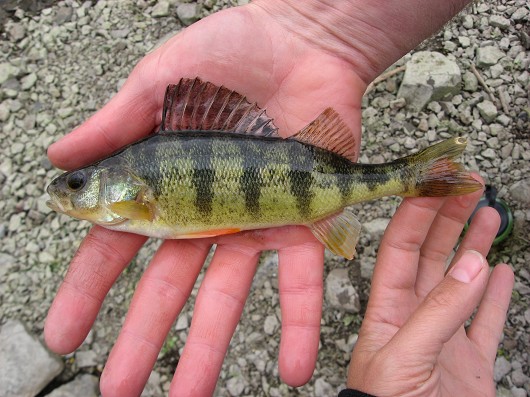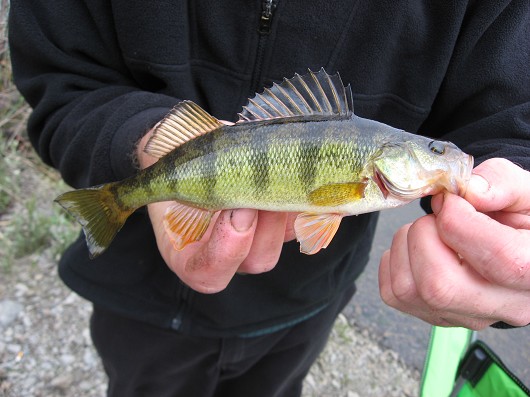Yellow Perch
-
Scientific NamePerca flavescens
-
NativeNo
-
Identification
 Yellow perch, caught in Iron Gate Reservoir, California on 13 May 2009 by Teejay O'Rear. Photo by Amber Manfree.
Yellow perch, caught in Iron Gate Reservoir, California on 13 May 2009 by Teejay O'Rear. Photo by Amber Manfree. Yellow perch (right side), caught in Iron Gate Reservoir, California on 13 May 2009 by Teejay O'Rear. Photo by Amber Manfree.
Yellow perch (right side), caught in Iron Gate Reservoir, California on 13 May 2009 by Teejay O'Rear. Photo by Amber Manfree.- Moderately deep and compressed body with a large head
- 2 well separated dorsal fins with 13-15 spines on the first and 2-3 spines and 12-14 rays on the second
- 2-8 spines and 6-8 rays on the anal fin
- Pelvic fins have 1 spine and 5 rays each
- Forked tail
- 52-61 large scales on the lateral line
- Yellow body and fins with 6-9 dark, vertical bars or saddles on each side
- Fins become reddish-orange in breeding males
-
Life History
Yellow Perch are most commonly found in the weedy backwaters of rivers, shallow waters of lakes, and large ponds, usually in warmwater situations. Populations can be found in coldwater lakes but these fish usually have stunted growth. Their optimal temperature range is 22-27°C but Yellow Perch can survive in water as warm as 32-33°C. They can also survive in salinities as high as 10 ppt and in dissolved oxygen levels less than 1 mg/L. They are a very social species with lake populations forming loose schools above beds of heavy plant growth, usually 1-10 m deep. Immature fish form schools of their own that tend to be tighter and in open waters 1-4 m deep. These younger fish feed on zooplankton, the variety of which increases with age. Benthic invertebrates, including insect larvae, snails, and crustaceans, make a larger portion of the Yellow Perch diet as they get older and move to shallower water. By the time they reach adulthood Yellow Perch are benthic specialists browsing plant beds for large invertebrates like crayfish, dragonfly larvae, and snails. Despite this specialization Yellow Perch are also known to catch small fish, including salmon, when they have the chance. Feeding occurs mostly at dawn and dusk with little to no activity at night.
Yellow Perch usually spawn in their second year, between April and May, when temperatures are 7-19°C. Mating begins with a female slowly swimming in circles near a vegetation bed, followed by 2-3 courting males fighting for position. When she is ready, the female will make a quick series of turns and movements before rapidly swimming forward, leaving a string of eggs in her wake for the males to fertilize. These strings are usually 30-50 cm in length but can be as long as 2 m. A single female will lay 4,000-121,000 eggs depending on her size. The embryos hatch 10-20 days later, and while the larvae immediately begin feeding on zooplankton, they retain their yolk sac until reaching approximately 7 mm in length. At this point they move away from their spawning area, drawn to the light of surface waters and then transported by the near-surface currents. By the end of their first year Yellow Perch will have grown to an average of 9 cm and will generally reach 27 cm by age 5. The largest individual found was a 13-year old, 53 cm long and weighing 1.9 kg, but fish over 30 cm in length, over 0.4 kg in weight, or older than 5 years are rare in California.
-
Links to Other ResearchN / A

